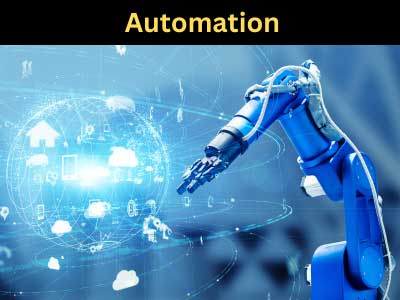Key Takeaway
Automation evolves in four stages. Stage 1 is Basic Automation, where simple machines reduce manual labor and increase efficiency. Stage 2, Advanced Automation, uses robotics and PLCs (Programmable Logic Controllers) to handle repetitive tasks with more accuracy. Stage 3, Intelligent Automation, integrates AI and machine learning, allowing systems to make data-based decisions. Finally, Stage 4, Cognitive Automation, combines AI with human-like thinking, enabling systems to learn and make decisions independently. Understanding these stages helps businesses apply the right level of automation for their needs.
Understanding Manual Processes
Manual processes mark the starting point of automation. In this stage, every task is performed by humans without any machine assistance. While manual work gives businesses full control and flexibility over operations, it’s labor-intensive, prone to human error, and inefficient for large-scale production. However, in small-scale industries or businesses just starting, manual processes are often necessary due to lower initial investment costs and the need for customization. The reliance on human effort also means slower output, inconsistent quality, and higher labor costs, but it remains an essential first step in understanding how operations flow.
For example, imagine a small factory assembling products by hand. Each product is crafted with care, but human involvement slows down the process and increases the possibility of mistakes. This stage often requires careful balancing between maintaining quality and pushing for higher output. Businesses operating at this stage often look for ways to streamline their processes and reduce waste, which leads them to the next stage—semi-automation.

Semi-Automation: The Transition Phase
Semi-automation is the bridge between manual processes and full automation. Here, some tasks are automated, but human input is still necessary for more complex or supervisory roles. Machines may take over repetitive, high-precision tasks like welding, cutting, or basic assembly, while humans handle decision-making, quality control, and troubleshooting. This stage is particularly beneficial for businesses with fluctuating production needs, as it provides flexibility and scalability while still boosting efficiency.
Semi-automation significantly reduces manual errors and speeds up production, allowing businesses to handle larger volumes more efficiently. However, integrating machines with human workflows can pose its challenges. Workers need to adapt to working alongside machines, and ensuring smooth coordination between human and automated tasks is key to maintaining productivity. Despite the challenges, semi-automation is often a cost-effective solution for medium-sized businesses looking to scale up operations without the full investment of full automation.
You May Like to Read
Full Automation: Achieving Maximum Efficiency
Full automation is the stage where machines take over almost every aspect of production, from material handling to packaging, assembly, and quality control. Human involvement is minimal, usually limited to machine maintenance, programming, and system oversight. By eliminating human error, full automation significantly improves efficiency, ensures consistent product quality, and increases production speed. This stage is ideal for businesses looking to scale up while maintaining high efficiency and low operating costs.
For example, in an automotive factory, robots are used to assemble, paint, and inspect vehicles with precision and speed that human workers cannot match. Full automation also allows businesses to operate 24/7 with minimal downtime, making it a game-changer for industries that require high output. However, full automation requires significant upfront investment in equipment, software, and training. Additionally, while the machines can work tirelessly, they require regular maintenance and upgrades to function optimally. Once these challenges are addressed, full automation provides a tremendous return on investment by boosting productivity and reducing long-term labor costs.
Integrated Automation: The Future of Manufacturing
Integrated automation is the final and most advanced stage of automation. In this phase, different automated systems work seamlessly together, often enhanced by technologies like IoT, AI, and machine learning. Machines communicate with one another, gather data, and make real-time adjustments to improve efficiency without human intervention. Integrated automation offers unparalleled scalability, allowing businesses to adapt to changing demands and market conditions instantly.
For example, a fully integrated factory might use IoT sensors to monitor machine performance and automatically adjust production speeds based on demand. If a machine detects an issue, AI-powered systems can either fix the problem automatically or alert technicians for intervention. Integrated automation enhances productivity, reduces downtime, and increases the accuracy of production processes. However, it comes with its own set of challenges. Setting up an integrated system requires advanced infrastructure, expertise, and significant financial investment. Despite these challenges, integrated automation is the future of manufacturing, offering a dynamic and adaptable solution for industries seeking to maintain a competitive edge.
Benefits and Challenges of Each Stage
Every stage of automation offers distinct benefits and challenges. Manual processes provide flexibility but are labor-intensive and slow. Semi-automation helps businesses improve efficiency by combining human and machine work, but managing this balance can be tricky. Full automation maximizes efficiency and consistency but demands high investment and technical maintenance. Integrated automation takes efficiency to the next level, offering real-time adaptability, though it requires advanced technologies and expertise to implement effectively.
Choosing the right stage of automation depends on the specific needs and resources of the business. Some industries may benefit from semi-automation due to the need for flexibility, while others, looking to scale massively, will find full or integrated automation indispensable. In any case, automation is a gradual process, and understanding each stage helps businesses navigate their growth toward optimal efficiency.
Conclusion
Understanding the stages of automation—from manual processes to integrated automation—is key for any business aiming to improve efficiency, reduce costs, and stay competitive. Each stage brings its own set of benefits and challenges, and moving through them strategically ensures a smoother transition toward optimal performance. Whether a business is just starting with manual operations or aiming for integrated automation, the journey is about continuous improvement. By making informed decisions at every stage, businesses can unlock the full potential of automation and set themselves up for long-term success.
